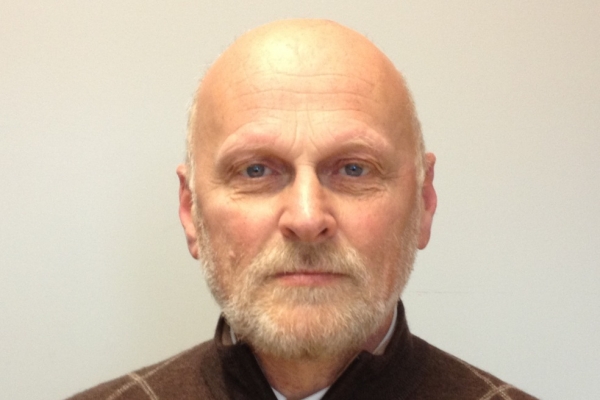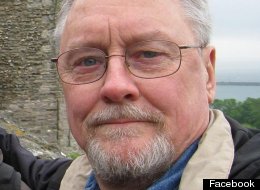Colloquium: Spring 2015 (Preparation Page)
Committee: Luca Grandi, Young-Kee Kim (chair), Dam Son, David Schuster
Colloquium at 4pm, followed by a reception (KPTC 206)
April 2, 2015
- Title: Self-Organization and Mechanics of Active Matter
- Speaker: Cristina Marchetti, Syracuse University

- Abstract: Bird flocks, bacterial suspensions, and colloids propelled by self-catalytic reactions are examples of active matter – collectives of individually driven, dissipative units with fascinating emergent behavior at large scales. Active systems self-organize in complex patterns, with transitions between ordered and disordered states, and spontaneously generate forces and sustained motion. In this talk I will highlight common properties of these diverse systems and describe recent progress in understanding and classifying their complex behavior using theory and simulations.
- Faculty Host: William Irvine
April 9, 2015
- Title: Geometry of Quantum Hall states
- Speaker: Paul Wiegmann, University of Chicago

- Abstract: Quantum Hall states are distinguished by a precise quantization of the Hall conductance in materials with imprecise characteristics. A natural question is whether the Hall conductance is a unique precise characteristic. Are there any other independent transport coefficients which are also precise on QH-plateaus? New theoretical arguments indicate that there are at least two more independent precise characteristics albeit up to now only the Hall conductance is experimentally accessible. These characteristics appear as a response of the states to deformation of geometry.
- Faculty Host: Dam Son
April 16, 2015
- Title: Harnessing ultraintense x-rays: understanding the atomic response and designing applications
- Speaker: Linda Young, Argonne National Laboratory

- Abstract: The first hard x-ray free-electron laser (XFEL) burst onto the world scene in 2009 at SLAC, bringing a billion-fold increased intensity for coherent, energy-tunable x-ray pulses. Beyond being a notable engineering feat, using 14-GeV electrons, 1-km linac and 100-m undulator, these intense x-ray pulses enable nonlinear x-ray processes, creation of novel states of matter and represent a starting point of the quest toward single biomolecule imaging. In this talk, I will discuss experiments designed to understand and control non-linear atomic response and their relationship to applications in warm dense matter research and serial femtosecond crystallography. Given these and other fascinating applications, the appetite for x-rays has grown and this talk will provide some perspectives on laser, storage ring and table-top x-ray facilities.
- Faculty Host: TBD
April 23, 2015
- Title: Understanding the retina through the lens of prediction
- Speaker: Stephanie Palmer, Neuroscience, the University of Chicago

- Abstract: Our brains perform a myriad of tasks that allow us to interact precisely and successfully with our environment. My research focuses on prediction, a ubiquitous and multifaceted computation in the brain necessary for overcoming sensory and motor delays as well as for longer term planning and decision-making. My present work focuses on the former type of fast prediction, which optimally compresses input signals along predictive dimensions potentially most relevant for behavior. I bring my training as a physicist to bear on these issues by evaluating the collective behavior of groups of neurons in the visual system and defining how these coordinated responses can optimally signal what will happen next in the world. We have shown that efficient predictive computation starts at the earliest stages of the visual system, in the retina. To further test whether the visual system performs optimal predictive compression and computation, we must characterize the ensemble of spatiotemporal correlations on which it must operate. To do so, we have constructed and analyzed a database of natural motion videos. I will discuss our current quantification of motion in this database, and highlight results from retina experiments using these movies as visual stimuli.
- Faculty Host: Young-Kee Kim
April 30, 2015 (Zachariasen Lecture)
- Title: Mott-Hubbard Transition in Ruthenium Perovskites
- Speaker: John Goodenough, Texas Austin

- Abstract: The Mott-Hubbard transition between localized and itinerant d-symmetry electrons is argued to be normally first-order rather than smooth. The Sr1-xCaxRuO3 perovskite system exhibits a Griffiths type paramagnetic susceptibility indicative of a segregation of localized RuIV electrons with zero magnetic moment in a ferromagnetic itinerant-electron matrix; the Sr1-xBaxRuO3. Perovskites synthesized under high pressure exhibit strong itinerant-electron ferromagnetism with Curie temperature and magnetization decreasing as x increases with an abrupt drop in BaRuO3 under high pressures indicative of delocalization of the majority-spin electrons. This behavior will be contrasted with that of the Sr1-xPbxRuO3 perovskites and the formation of a Pb-Ru covalent bond in the PbRuO3 perovskite under high pressure.
- Faculty Host: Ed Blucher
May 7, 2015
- Title: Here be dragons: mysteries of the neutrino
- Speaker: Gabriel Orebi Gann, U.C. Berkeley

- Abstract: Neutrinos are one of the most fascinating particles that occur in nature: hundreds of millions of times smaller than the proton, the neutrino was once thought to be massless and to travel at the speed of light. Huge strides have been made in our understanding of neutrinos in past decades, with the resolution of the solar neutrino problem providing clear evidence of neutrino oscillation and, thus, a non-zero neutrino mass. This has allowed us to move beyond basic questions to a precision era, in which we can study further properties of these fundamental particles. This talk will introduce the SNO+ experiment, which will seek to resolve the very nature of the neutrino: is it unique among fermions as being its own antiparticle? We will then discuss future prospects for the field, including exciting new technical developments that could permit a new kind of neutrino experiment, with a broad experimental program and wide physics reach.
- Faculty Host: Luca Grandi
May 14, 2015
- Title: Building with Crystals of Light and Quantum Matter: From clocks to computers
- Speaker: Ana Maria Rey, University of Colorado, Boulder

- Abstract: Understanding the behavior of interacting electrons in solids or liquids is at the heart of modern quantum science and necessary for technological advances. However, the complexity of their interactions generally prevents us from coming up with an exact mathematical description of their behavior. Precisely engineered ultracold gases are emerging as a powerful tool for unraveling these challenging physical problems. In this talk, I will present recent developments at JILA on using atoms in crystals of light for the investigation of complex many-body phenomena and magnetism. Iwill also discuss a new research direction of using atomic clocks not only as precise time keepers but also as unique quantum laboratories for the investigation of new forms of matter with no known counterpart in nature.
- Faculty Host: Cheng Chin
May 21, 2015
- Title: The three-body Efimov effect and extensions to more bodies
- Speaker: Doerte Blume, Washington State University

- Abstract: The quantum mechanical three-body problem has been studied extensively for about a century. The helium atom (two electrons and a nuclues) and the molecular hydrogen ion (two protons and one electron) are textbook examples that illustrate the organization of the periodic table and molecular binding mechanisms, respectively. In 1970 Vitaly Efimov predicted a rather different and counterintuive quantum mechanical three-body binding mechanism that leads to an infinite series of stable three-body states of enormous spatial extents. These Efimov states are predicted to exist for short-range interactions like the van der Waals force between atoms or the strong force between nucleons. When the potential becomes so shallow that the last two-body bound state is at the verge of becoming unbound or is unbound, then three particles stick together to form Efimov states. This talk will review recent theoretical and experimental advances in this field. The observation of the helium trimer (three neutral helium atoms) Efimov state and extensions of the Efimov scenario to four- and higher-body systems will be discussed.
- Faculty Host: Cheng Chin
May 28, 2015
- Title: Little Boy, Fat Man, and Nuclear Archeology
- Speaker: John Coster-Mullen

- Abstract: I employ the term “Nuclear Archeology” to describe my primary research methods over the past two decades used to uncover the secrets of the first atomic bombs, Little Boy and Fat Man. Much of the pioneering research on these weapons started here at the University of Chicago. My talk will reveal many of these secrets which, paradoxically, are not secret at all but are openly available to the nuclear archeologist. They have merely been hiding in plain sight waiting patiently to be discovered.
- Faculty Host: Henry Frisch
June 4, 2015
- Title: Nanoparticles in liquid crystals, and liquid crystals in nanoparticles
- Speaker: Juan de Pablo

- Abstract: Liquid crystals are remarkably sensitive to interfacial interactions. Small perturbations at a liquid crystal interface can in fact be amplified over relative long distances, thereby providing the basis for a wide range of applications. Our recent research efforts have focused on the reverse phenomenon; that is, we have sought to manipulate the interfacial assembly of nanoparticles or the organization of surface active molecules by controlling the structure of a liquid crystal. This presentation will consist of a review of the basic principles that are responsible for liquid crystal-mediated interactions, followed by demonstrations of those principles in the context of two types of systems. In the first, a liquid crystal is used to direct the assembly of nanoparticles; through a combination of molecular and continuum models, it is found that minute changes in interfacial energy and particle size lead to liquid-crystal induced attractions that can span multiple orders of magnitude. Theoretical predictions are confirmed by experimental observations, which also suggest that LC-mediated assembly provides an effective means for fabrication of organized nanoparticle arrays. In the second application, the structure of a liquid crystal is controlled by confinement. It is shown that when confined to submicron droplets, the morphology of the liquid crystal depends on a delicate balance between bulk and interfacial contributions to the free energy; that balance can be easily perturbed by adsorption of analytes at the interface, thereby providing the basis for development of chemical or biological sensors. Theoretical predictions also indicate that the three-dimensional order of a liquid crystal can be projected onto a two-dimensional interface, and give rise to intriguing nanostructures that are not found in simple isotropic fluids.
- Faculty Host: Heinrich Jaeger